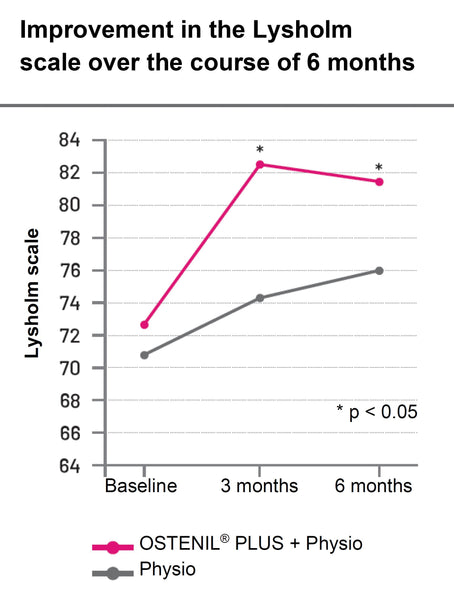Chondromalacia Patellae:
OSTENIL PLUS plus Physiotherapy is More Effective than Physiotherapy Alone

Chondromalacia Patellae (CMP) is one of the most common causes of chronic knee pain, with high rates of presentation in sports medicine and orthopaedic practice. CMP defines anterior knee pain due to physical and biomechanical changes; typically emanating from abnormal change affecting articular cartilage on the posterior surface of the patella, which may manifest as swelling, fibrillation and erosion of hyaline cartilage and sclerosis of underlying bone. CMP can be attributed to injury, overuse and/or structural misalignment, and is particularly prevalent in teenage and adult performance-oriented athletes. Treatment typically consists of conservative therapy, often with focus on physiotherapeutic exercises with the aim of stretching and strengthening surrounding hamstring, quadriceps, gastrocnemius and gluteal musculature.
In a pilot study, Astur et al.* evaluated the effectiveness of a single intra-articular injection of sodium hyaluronate (Ostenil Plus®) in combination with physiotherapy versus physiotherapy alone, for treatment of CMP.
70 patients suffering anterior knee pain diagnosed with chondromalacia patellae were recruited for this prospective randomised clinical trial. Inclusion criteria stipulated patients were aged 18-45 years and physically active - participating in a minimum of 3x sports activity sessions per week, with patellar cartilage lesion <2cm2 classified grade II or III according to the International Cartilage Repair Society (ICRS), and with good knee alignment (-1 to -3° of tibiofemoral angulation). The study group received one intra-articular injection of Ostenil Plus® (2% sodium hyaluronate with mannitol) and completed a 12-week physiotherapy programme; control group completed the 12-week physiotherapy programme only. Outcome measures included VAS pain, Lysholm scale and Kujala scale at baseline, 3 and 6 months. Clarke’s test was also performed prior to and upon completion of the study.

Improvement in pain (VAS) from baseline was observed in both groups, reaching statistical significance at 3 and 6 months (p < 0.05). Furthermore, study group patients receiving Ostenil Plus® intra-articular injection experienced significantly less pain at 3 and 6 months compared with the control group; this between-group difference was statistically significant at both timepoints (p < 0.05).
The Lysholm scale is a point scoring system reporting knee-specific symptoms including mechanical locking, instability, pain, swelling, stair climbing, and squatting. At 3 months the study group reported an increase of 10 points from baseline compared with an increase of 3.5 points in the control group. At 6 months a 5.6 point difference was maintained between-groups. At both 3 and 6 months, patients receiving Ostenil Plus® intra-articular injection scored significantly higher Lysholm scores than patients receiving physiotherapy alone (p < 0.05).

The Kuala scale is a patient reported assessment of patellofemoral disorders that reports subjective symptoms and functional limitations. At 3 months the study group reported an increase of 12.8 points from baseline compared with an increase of 4.9 points in the control group. At 6 months the reported increase from baseline was 13.2 in the study group and 7.0 points in the control group. At both 3 and 6 months, patients receiving Ostenil Plus® intra-articular injection achieved significantly higher Kuala scores than patients receiving physiotherapy alone (p < 0.05).

Prior to treatment, 93.5% of study group patients recorded a positive Clarke’s test, as did 90% of the control group. At 6 months, Clarke’s test remained positive for 38.7% of the study group patients compared with 68.7% of control group patients. Patients receiving Ostenil Plus® intra-articular injection experienced less pain than patients receiving physiotherapy alone (p = 0.02).
CONCLUSION: For treatment of Chondromalacia Patellae, a single intra-articular injection of Ostenil Plus® combined with physiotherapy, leads to a significantly greater reduction in pain and improvement in functional deficit over 6 months compared with physiotherapy alone.
* Astur DC, Angelini FB, Santos MA, Arliani GG, Belangero PS, Cohen M. Use of Exogenous Hyaluronic Acid for the Treatment of Patellar Chondropathy- A Six-Month Randomized Controlled Trial. Rev Bras Ortop (Sao Paulo). 2019 Sep;54(5):549-555. doi: 10.1055/s-0039-1697974. Epub 2019 Oct 29. PMID: 31686712; PMCID: PMC6819163.
